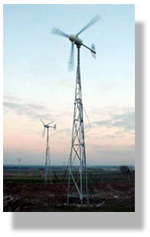The Upper Midwest is a Model...
State Options for Community Wind Power Development
A new case study, A Survey of State Support for Community Wind Power Development, describes various policies and incentives that states are using to support community wind power development. These are projects consisting of one or more locally owned, utility-scale wind turbines interconnected on either the customer or utility side of the meter. The study also details how state and federal support influences the types of projects that are developed.

in action
Lawrence Berkeley National Laboratory, in conjunction with the Clean Energy States Alliance, has announced the release of the latest installment in the case study series, Case Studies of State Support for Renewable Energy.
Once primarily a European phenomenon, community wind power development is attracting the attention of an increasing number of states for a variety of reasons. In the upper Midwest, for example, "community wind" is seen as a way to supplement and stabilize farmer incomes, and to promote rural economic development. In the Northeast, which has to date seen relatively little wind power development, states are turning to community wind as a way to enhance the public's knowledge, perception and acceptance of wind power.
The majority of this study focuses on the upper Midwest, and in particular Minnesota, which is both the birthplace and current "hotbed" of community wind power development in the United States. Other states covered include Wisconsin, Iowa, Illinois, Massachusetts and New York. Experience in these states demonstrates that, with an array of incentives and creative financing schemes targeted at community-scale projects, there are opportunities to make community wind work in the United States.